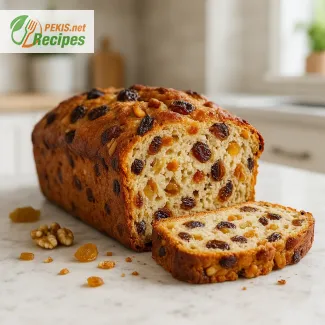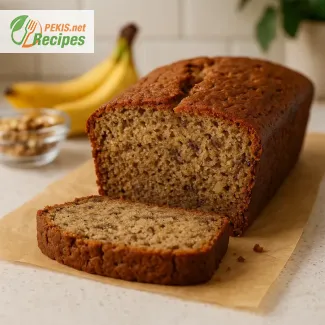
Nourishing Artisan Loaf with Buckwheat and Seeds
Discover the heartiness of rustic baking with this wholesome buckwheat bread
There's something timeless and deeply comforting about a rustic gluten-free bread, especially one made with buckwheat flour, a naturally gluten-free pseudo-grain prized for its earthy aroma and robust flavor. This Gluten-Free Rustic Buckwheat Bread Recipe draws from traditional European farmhouse loaves, bringing together ancient grains and seeds to form a nutrient-dense, satisfying loaf ideal for everyday use. Whether you're avoiding gluten for medical reasons or simply seeking an alternative to wheat-based bread, this recipe offers both taste and texture in every bite.
Why buckwheat is the star of gluten-free artisan bread
Although its name suggests otherwise, buckwheat contains no gluten, making it a powerful staple for anyone following a gluten-free lifestyle. It is not a cereal grain but rather a seed, and its rich, nutty profile provides depth that’s often missing in standard gluten-free breads. Buckwheat flour lends a naturally dense yet soft crumb, while also offering excellent structure when paired with binding agents like psyllium husk or ground flaxseeds. This makes it ideal for crafting a hearty, artisan-style bread without the use of commercial additives.
Because buckwheat absorbs water differently than refined gluten-free flour blends, it gives the dough a moist, pliable texture that holds well after baking. Its natural bitterness is beautifully balanced with a touch of maple syrup or honey in the dough, creating layers of flavor that are complex yet approachable. When toasted, the crust becomes deeply golden and crisp, giving way to a tender, rustic interior that’s perfect for slathering with butter, dips, or avocado.
Crafting structure without gluten: the magic of psyllium and flax
Gluten provides elasticity in traditional bread, trapping air bubbles that help it rise and maintain shape. Without it, gluten-free loaves can easily collapse or become overly crumbly. The solution lies in fiber-rich binders that mimic the structural role of gluten. In this recipe, psyllium husk plays a key part. When hydrated, it forms a gel that stabilizes the dough, helping it hold air pockets during baking. Combined with ground flaxseed, which also gels in the presence of moisture, the result is a well-structured, springy loaf that slices cleanly and holds its shape.
This strategic pairing not only enhances texture but also boosts the fiber content significantly, supporting digestion and offering prolonged satiety. The use of seeds like sunflower and chia not only provides additional structural integrity but also contributes to a nutty crunch, making this bread more than just a gluten-free alternative—it becomes a culinary experience in its own right.
Fermentation, flavor, and rustic authenticity
Unlike quick gluten-free breads that rely on baking powder or soda for leavening, this recipe uses active dry yeast to produce a gentle fermentation. The slower rising time allows enzymes in the dough to break down complex carbohydrates and develop a more refined flavor profile, echoing the experience of sourdough baking without the need for a starter. This process also encourages the formation of a slightly open crumb, creating the kind of rustic texture typically found in wood-fired bakery loaves.
Letting the dough rest and ferment longer allows the buckwheat to deepen in taste, giving the final product a toasty, roasted aroma. The surface can be dusted with seeds or coarse salt, adding visual appeal and a delightful crunch with every bite. For optimal crust development, baking in a preheated Dutch oven or using steam in the first part of baking ensures a thick, golden crust that crackles as it cools.
Versatile serving options and everyday enjoyment
This gluten-free buckwheat bread is ideal for both sweet and savory pairings. Toast it and top with almond butter and berries for a hearty breakfast, or serve alongside soups and salads as a nourishing accompaniment. Its dense structure makes it perfect for open-faced sandwiches, grilled cheese, or even used as a base for bruschetta. Because of its lasting moisture, this bread keeps well for several days at room temperature and freezes beautifully in slices, making it a convenient staple for weekly meal prep.
Whether enjoyed warm out of the oven or as a foundation for your favorite toppings, this bread represents the perfect blend of traditional technique and modern dietary needs. With its rich buckwheat base, structural support from natural binders, and flavorful seed inclusions, it satisfies not only gluten-free requirements but also the cravings of any bread lover looking for authenticity, texture, and depth.
Step 1: Activate the yeast
In a large mixing bowl, combine the lukewarm water (400 ml / 1 ⅔ cups), maple syrup (10 ml / 2 tsp), and dry yeast (7 g / 2 ¼ tsp). Let it sit for about 10 minutes until it becomes frothy and active.
Step 2: Mix dry ingredients
In a separate bowl, whisk together buckwheat flour (300 g / 2 ½ cups), tapioca starch (100 g / ⅔ cup), psyllium husk powder (15 g / 1 ½ tbsp), ground flaxseed (20 g / 2 tbsp), sunflower seeds (30 g / 2 tbsp), chia seeds (10 g / 1 tbsp), and fine sea salt (5 g / 1 tsp).
Step 3: Combine and knead
Pour the dry ingredients into the yeast mixture. Add the apple cider vinegar (15 ml / 1 tbsp) and olive oil (15 ml / 1 tbsp). Mix well with a wooden spoon or your hands until a sticky dough forms. Allow the dough to rest for 10 minutes to let the psyllium and flax absorb moisture.
Step 4: Shape and proof
Transfer the dough to a lightly oiled loaf pan (approximately 20 cm x 10 cm / 8 inch x 4 inch). Smooth the top with wet hands or a spatula. Cover the pan with a clean kitchen towel and let it rise in a warm place for 60 minutes or until the dough has visibly expanded.
Step 5: Bake
Preheat the oven to 200°C (390°F). Place the loaf in the middle of the oven and bake for 60 minutes. For a crispier crust, remove the loaf from the pan in the last 10 minutes and bake directly on the oven rack.
Step 6: Cool
Allow the bread to cool completely on a wire rack before slicing to prevent a gummy interior.
Elevating the Flavor and Texture of Gluten-Free Buckwheat Bread
Expert tips to refine and personalize your rustic buckwheat loaf
The beauty of baking lies in the ability to adapt and evolve. Even a well-balanced and hearty gluten-free rustic buckwheat bread recipe can be elevated through thoughtful adjustments. Whether you're aiming for a lighter crumb, enhanced flavor depth, improved nutrition, or simply personal taste preferences, small modifications can lead to significant results. Here are professional insights and creative tips on how to improve and customize this wholesome buckwheat loaf for exceptional outcomes every time.
Enhance taste through ingredient variation
One of the easiest ways to boost flavor in this recipe is by integrating roasted seeds or nuts into the dough. Replacing regular sunflower seeds with lightly toasted pumpkin seeds adds a richer, buttery note, while chopped walnuts or hazelnuts contribute a deeper, earthy aroma and slight crunch. If using seeds, ensure they are dry-roasted without oil to avoid excess moisture in the dough.
Another effective enhancement is to incorporate a sourdough starter. Though the base recipe uses dry yeast, adding 100 g (½ cup) of gluten-free sourdough starter will lend a subtle tang and complex umami flavor, transforming the overall experience of the loaf. Just be sure to reduce the amount of water slightly and extend the fermentation time to accommodate the slower rise.
For a mildly sweet and aromatic dimension, include caramelized onions or a pinch of dried rosemary or thyme. These ingredients amplify the rustic character of the bread, especially when served warm or paired with savory spreads.
Adjusting moisture and crumb texture
Gluten-free doughs are highly sensitive to hydration levels. If the loaf turns out too dense or dry, slightly increase the water by 30–50 ml (2–3 tbsp) and allow a longer resting period before baking. Alternatively, substitute part of the water with unsweetened plant-based milk, such as almond or oat milk, to create a softer crumb and more delicate crust.
If a lighter, airier interior is desired, incorporate 1 tbsp of apple puree or mashed cooked sweet potato. These ingredients act as natural moisturizers and add slight sweetness, balancing the buckwheat's earthy undertones. They also improve elasticity and can help with the loaf's rise.
Health-conscious upgrades
This bread is already packed with fiber and nutrients, but it can be further fortified. Replace part of the buckwheat flour with teff or amaranth flour—both are ancient gluten-free grains with high mineral content. Teff adds a mild molasses-like sweetness, while amaranth gives a nutty, grassy flavor.
You can also upgrade the oil in the recipe by replacing standard olive oil with cold-pressed flaxseed oil or walnut oil, both of which increase the omega-3 fatty acid content and add unique fragrance notes.
To lower the glycemic index, reduce or omit the maple syrup and use yacon syrup or a small amount of green banana flour, which is rich in resistant starch and beneficial for blood sugar regulation.
Avoiding common mistakes in gluten-free baking
Baking without gluten requires special attention to method and timing. One of the most common mistakes is underhydrating the dough, leading to a crumbly and dry loaf. Always allow time for the psyllium husk and flaxseeds to fully absorb moisture before shaping.
Another pitfall is overproofing, especially in warm kitchens. Without gluten, the dough cannot trap air as effectively, and if left to rise too long, it can collapse in the oven. Keep the proofing time within 45–60 minutes and observe the dough closely.
Avoid cutting the bread too soon after baking. Gluten-free breads retain steam longer, and slicing into them prematurely can cause a gummy interior. Always let the loaf cool completely on a wire rack before slicing.
Advantages of baking at home versus store-bought alternatives
Commercial gluten-free breads often rely on refined starches, gums, and preservatives to simulate texture and extend shelf life. While convenient, they often lack the nutritional depth, fiber, and natural flavor of homemade alternatives. Baking at home gives you full control over ingredients, hydration, flavor, and portion size.
Moreover, this recipe uses whole-food ingredients that support gut health and provide sustained energy. By using fresh seeds, clean flours, and natural fermentation techniques, the final product becomes not just a bread substitute—but a nourishing staple.
Creative presentation and serving options
Beyond toasting and sandwiching, this rustic loaf shines when used creatively. Try cubing and baking slices into herb-seasoned croutons, or slice thinly and toast into crisp flatbreads for dips and spreads. The dense texture also makes it excellent for pan-grilled bruschetta or open-face tartines topped with hummus, avocado, or goat cheese.
Add a touch of sweetness by serving it with nut butter and fresh fruit, or infuse savory depth by brushing slices with garlic oil before grilling.
Adapting for dietary preferences and seasonal pairings
For a nut-free variation, replace flaxseed with ground sunflower meal and avoid any nut-based toppings. If you're cooking in colder seasons, adding warming spices like cumin or caraway can deepen the bread’s aroma and make it feel more grounded and comforting.
In warmer months, serve slices chilled with tomato salad, cucumber spreads, or lightly marinated tofu for a cooling, refreshing contrast to the bread's dense structure.
Every loaf you bake becomes a canvas for adaptation. By tuning the ingredients and methods to your preferences, this buckwheat-based bread becomes far more than a gluten-free alternative—it becomes a flavorful, versatile companion to any meal.
Allergens present in the recipe:
- None (naturally gluten-free and free from major allergens)
Substitution tips for allergens and gluten:
- This recipe is already gluten-free.
- To avoid potential seed allergens (chia or sunflower), you may substitute with hemp seeds or omit them entirely.
Vitamins and minerals per serving (approximate):
- Magnesium: 85 mg – supports muscle and nerve function
- Manganese: 0.8 mg – essential for metabolism and bone health
- Iron: 2 mg – contributes to oxygen transport in the blood
- Zinc: 1.5 mg – supports immune system
- Vitamin B1 (Thiamine): 0.1 mg – important for energy metabolism
- Folate (B9): 30 µg – aids in cell division and red blood cell formation
Antioxidants per serving (approximate):
- Rutin: 20 mg – a flavonoid found in buckwheat, promotes vascular health and reduces inflammation
- Lignans: 5 mg – from flaxseeds, supports hormonal balance and heart health
- Phenolic acids: 12 mg – protect cells from oxidative damage and contribute to anti-aging effects





